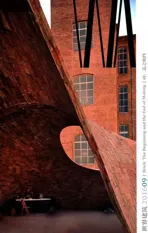水井街酒坊遗址博物馆,成都,中国
2016-10-19建筑设计刘家琨家琨建筑设计事务所A
建筑设计:刘家琨/家琨建筑设计事务所A
rchitects: LIU Jiakun/Jiakun Architects
水井街酒坊遗址博物馆,成都,中国
Shuijingfang Museum, Chengdu, China, 2013
建筑设计:刘家琨/家琨建筑设计事务所A
rchitects: LIU Jiakun/Jiakun Architects
基地概述
水井坊遗址位于成都市水井坊历史文化街区内,基地周围为保留民居(后周边民居被逐步拆除,拟仿造翻建)。基地内有古井、门楼、民国时期木屋架酿酒生产车间、元代酒窖遗址等文物古迹。
项目宗旨
水井坊遗址博物馆属于酒类主题博物馆,主要功能是展示水井坊的悠久历史和珍贵出土文物,保护与传承传统工业文明遗产。水井坊遗址博物馆既展示了成都平原传统酒文化,又提升了整个水井坊片区的社区文化氛围。
建筑与街区
建筑整体以民居建筑尺度为基础,采用聚合的小体量,缝合相邻历史街区肌理。设计师以错动的手法柔化建筑边界,使之与保护区肌理平滑过渡,融为一体。屋顶以周边民居重叠往复的屋顶为原型,进行变形错动,以连续折线的坡屋顶,形成与民居肌理一致的屋顶景观,使建筑融入水井坊历史文化街区。
新建与保护
基地内部有文物建筑——民国时期的酿酒作坊厂房和明清时期晾堂挖掘遗址现场,其中的酒窖仍在使用中,是博物馆展示工业文明遗产的重要部分。这些重要的文物一起构成了博物馆的遗址展示区。一切以对文物遗址的保护与尊重为前提,进行稳妥谦逊的加建设计,既不能简单仿造以假乱真,又不能突兀张扬喧宾夺主,应在继承传统气质的基础上有所创新,探讨新旧共处的关系。
新建博物馆以“衬托”为原则,新建部分与老作坊之间的保护带,形成与老民居片区相似纵横街巷,以“合抱”的姿态对遗址展示区进行保护。新建建筑以单一的材料弱化立面表现性,达到衬托文物本体(原有厂房及遗址)的目的。
木构架老厂房内部仍以传统酿酒工艺进行生产,当代酿酒工艺被置于新建混凝土厂房内。新建厂房采用清水混凝土和单向梁框架结构,而不是原有厂房的传统木构架。新建筑的“狮子口”屋顶形式是老厂房采光口的提炼与组合,以形成与老厂房一致的通风、采光环境(窖菌的发酵依赖特定的空气、光照、土壤条件),光线幽暗,糟香氤氲,新老建筑共同延续了酿酒工艺的历史发展脉络,使水井坊遗址博物馆成为集保护、展示、生产、交流于一体的活着的文化遗产。
建筑处理
博物馆沿街设置矮墙,结合现状槐树,保持原有街道尺度,维持水井坊街区尺度和氛围。
博物馆入口谦逊平和,其尺度接近民居。矮墙与入口围合出入口庭院。院内以旧砖铺地,形成喧闹城市一角安静之地。
沿参观流线交替设置的天井院落与展厅,营造了气氛张弛有度的参观节奏。各具特色的天井也成为丰富蜀文化的载体。古井庭院、牌坊庭院,均设置有独立的院落天井,既强调了文物的重要性,也是转换室内外空间、丰富参观体验的重要手段。
流线与功能
参观流线按照两条线索设置:一是酿酒工艺的先后顺序,二是从传统到当代的时间顺序。参观栈道架空于酒窖区与遗址之上,栈道下生产可顺利进行,生产流线与参观流线互不交叉干扰。沿参观流线可纵览酒窖发酵、基酒储存、勾兑、包装等生产全过程。
遗址展示区北侧为酒文化中心,以天井为主题进行空间组织,形式灵活多变,可以用作临时主题展览、学术会议交流活动等,并设计有单独的出入口,方便独立运作。
建筑材料
建筑采用当代材料“转译”传统材料,以再生砖对应青砖,重竹对应木板,瓦板岩对应小青瓦,是对传统建筑气质的继承和更新,以此构建出手法现代、韵味传统的建筑群落。

1 鸟瞰/Aerial view
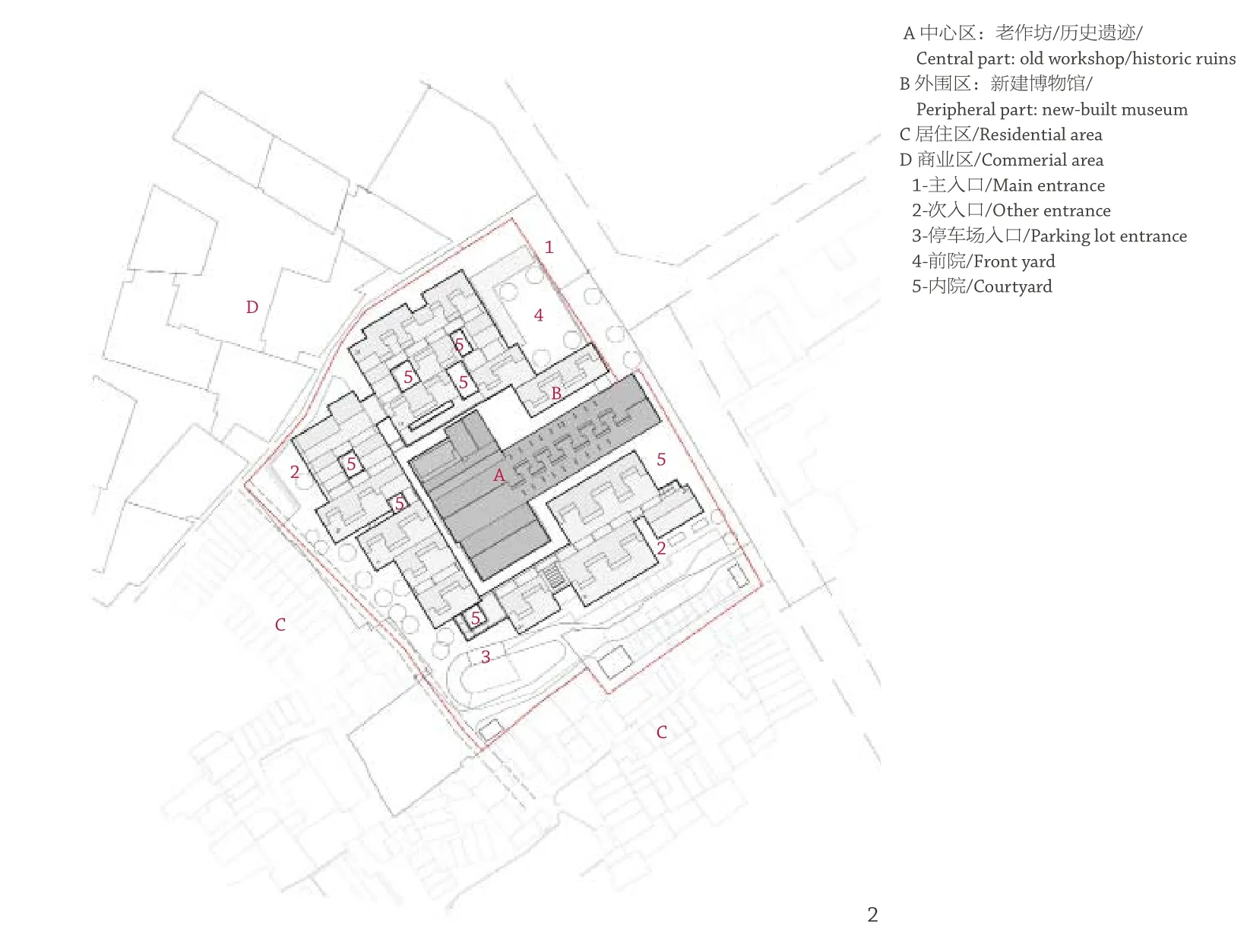
2 总平面/Site plan
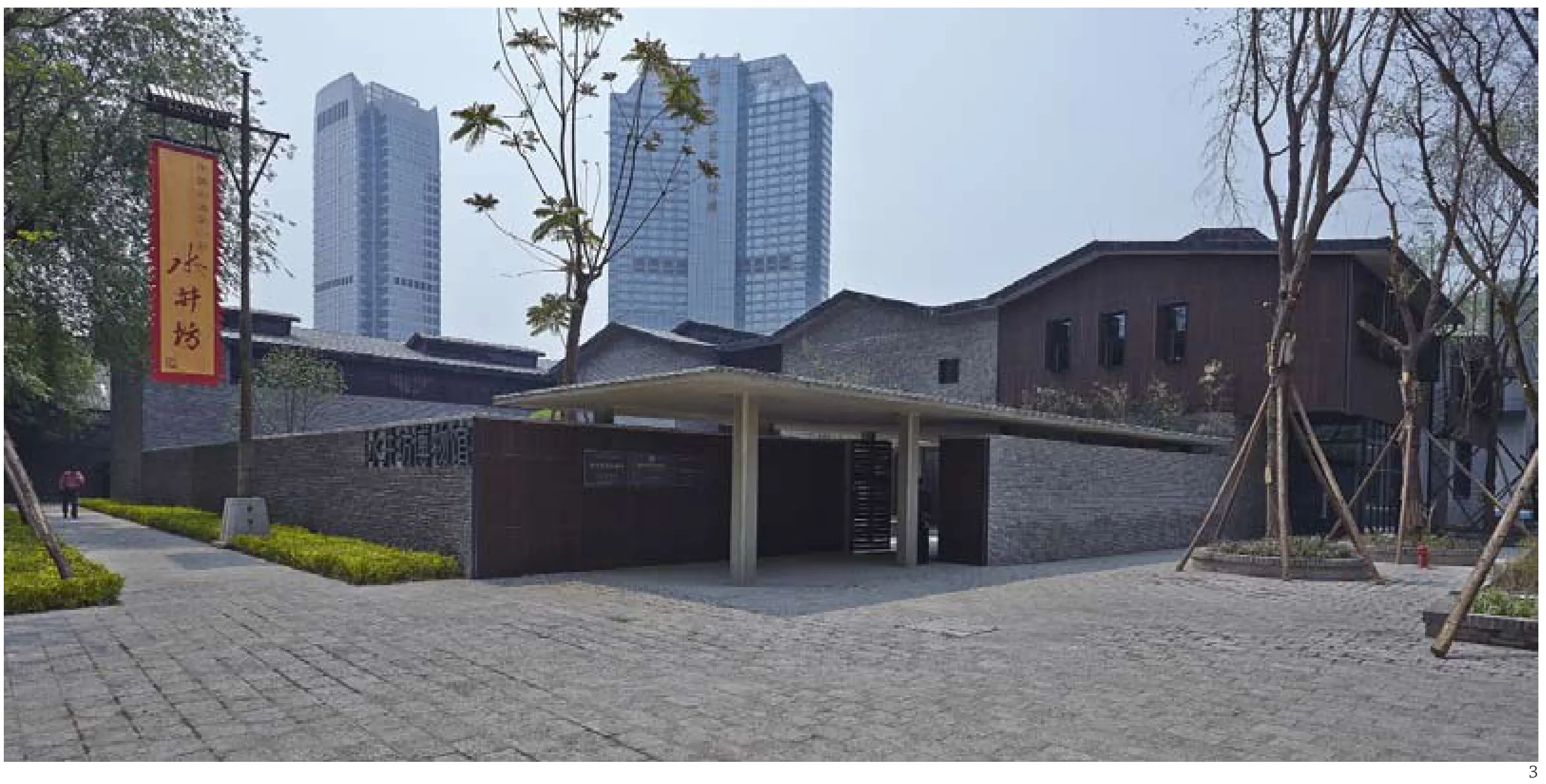
3 入口/Entrance
项目信息/Credits and Data
客户/C lient: 四川水井坊股份有限公司/Sichuan Shuijingfang Company Ltd.
主创建筑师/Principle Architect: 刘家琨/LIU Jiakun
设计团队/Design Team: 蔡克非,华益,杨东/CAI Kefei,HUA Yi, YANG Dong
结构/Structure: 钢筋混凝土框架/Reinforced concrete frame
主要材料/Material: 再生砖,防腐重竹/Rebirth brick and antiseptic consolidated bamboo
场地面积/Site Area: 12,148m2
建筑面积/Floor Area: 8670m2
设计时间/Design Period: 2008.08 – 2011.09
施工时间/Construction Period: 2011.09 – 2013.04
摄影/Photos: 存在建筑/ARCHEXIST
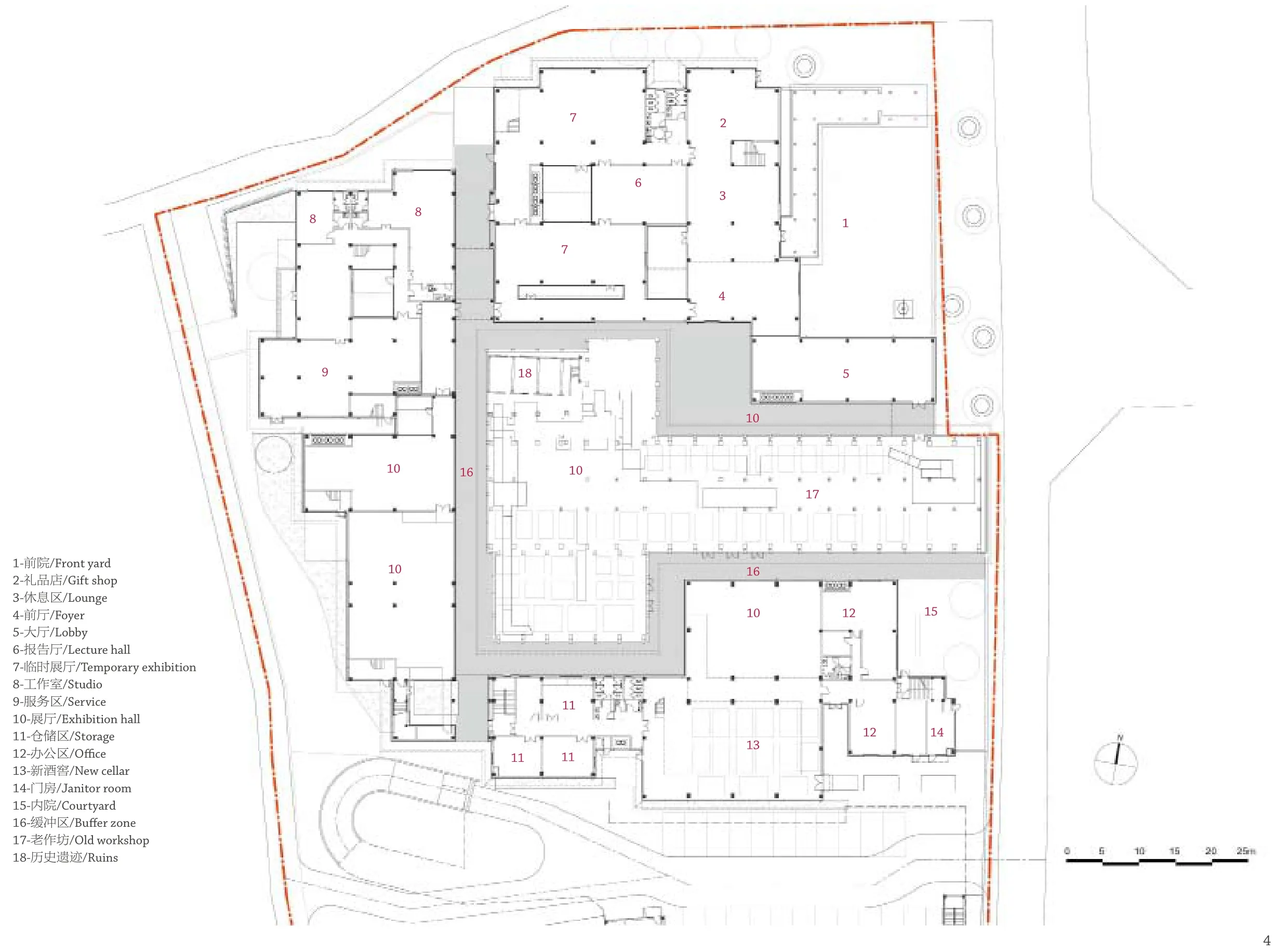
4 首层平面/Floor 0 plan
An Overview of the Site
Located in Shuijinfang Historic District in Chengdu, Shuijingfang Museum is surrounded by preserved folk houses (later the surrounding dwellings were gradually demolished and will be replaced by rebuilt houses in imitation of the old ones). In this area, there also are a number of cultural relics and historic sites such as ancient well,gate tower, wooden-roof-truss liquor brewing and production workshop of the Republican Period, and liquor cellar ruins of Yuan Dynasty.
Project Purpose
As a liquor-themed museum, the museum mainly demonstrates the long history and precious unearthed relics of Shuijingfang, and intends to preserve and inherit traditional industrial heritages. It not only demonstrates the traditional liquor culture of the region of Chengdu Plain, but also enhances the cultural environment of the whole neighborhood.
Architecture and the Neighborhood
Based on the size and style of the surrounding residential buildings, the museum adopts aggregated small-volume structure to fit into the texture of the adjacent historic district. Designers use the technique of dislocation to soften building boundaries, and embed the building in the preserved area smoothly. The design of the roof takes the overlapping and cyclical roofs of surrounding folk houses as the prototype, and makes variations and dislocation to form a continuous zigzag pitched roof,so as to create a rooftop view that is consistent with neighborhood texture and to integrate the museum into Shuijingfang Historic Neighborhood.
New Construction and Preservation
There are historic buildings inside the site: the workshop of liquor brew house of the Republic and the excavation site of the drying house of Ming and Qing dynasties. The liquor cellar is still in use, which is an important part of the exhibition of industrial civilization heritages in the museum. These valuable historic relics altogether constitute the museum's exhibition area of heritages.
On the premise of preserving and paying homage to the historic site, safe and modest new buildings are designed, which should be neither simple imitation of the genuine folk houses, nor too abrupt to overshadow the surrounding houses. The design should be innovative on the basis of inheriting the traditional quality, and explore the coexistence between the new and old buildings.
Adopting a low profile as a principle of design,vertical and horizontal alleys are formed in the preservation zone between the newly built part and the old workshop, which protects the relic exhibition area with an "encircling" gesture. The new buildings use a single material to weaken the facade expression, so as to achieve the effect to foreground and highlight the cultural relics (i.e., the original workshop and ruins).
Inside the old wood-framed workshop, the traditional brewing technique is still used to produce liquor, while the modern brewing process is found in the newly built concrete plant. The new plant is built with fair-faced concrete and unidirectional beam frame structure rather than the traditionalwooden structure of the original workshop. The "lion's mouth-shaped" roof of the new building is the extraction and combination of daylight opening of the old workshop, so as to ensure environmentally consistence with the old workshop concerning ventilation and lighting (the fermentation of the bacteria in the cellar requires specific air, light, and soil conditions). With the same dim lights and liquor aroma, new buildings and old buildings together pass on the historical development of the brewing technique, thus making Shuijingfang Museum a living cultural heritage that integrates the functions of preservation, exhibition, production, and cultural exchange.
Architectural Design
Surrounding the museum, low walls are built along the street, which, together with existing locust trees, preserves the original street scale and maintains the size and atmosphere of Shuijingfang neighborhood.
The entrance to the museum is modest, with a scale close to nearby folk houses. Low walls and the entrance enclose the access courtyard. The courtyard is paved with old bricks, forming a quiet place in the noisy city.
The alternately arranged courtyards and exhibition halls along the circulation for visitors create a well-balanced rhythm. Atriums with different characteristics also become carriers of rich Sichuan culture. The ancient well courtyard and the archway courtyard both have a separate atrium,which not only emphasizes the importance of cultural relics, but also acts as a way to switch indoor and outdoor spaces and enrich visit experience.
Circulation and Function
The circulation for visitors is set according to two clues: one is the sequence of the brewing process, and the other is the chronological order from the traditional to the contemporary. Visit walkway is built on top of the cellar and the ruins, so that production under the walkway can be processed smoothly. The production line and the visiting line do not interfere with each other. Follow the visiting line, visitors can walk through the museum and view the entire production process from brewing, basic liquor storage, blending, to packaging.
The northern part of the exhibition hall is the center of liquor culture. Spatial organization is based on courtyards with different themes,whose form is flexible and changeable. They can be used for temporary themed exhibitions, academic conferences and exchanges, etc. Separate entrances and exits are placed for different courtyards with convenience for independent operations.
Building Materials
The building uses contemporary materials to "translate" traditional materials, such as recycled bricks in response to traditional black bricks, anticorrosive bamboo panels to laminated wood boards,and roofing slates to Chinese-style tiles. It is the inheritance and update of traditional architectural temperament, based on which a building group with modern techniques but traditional charm is created.
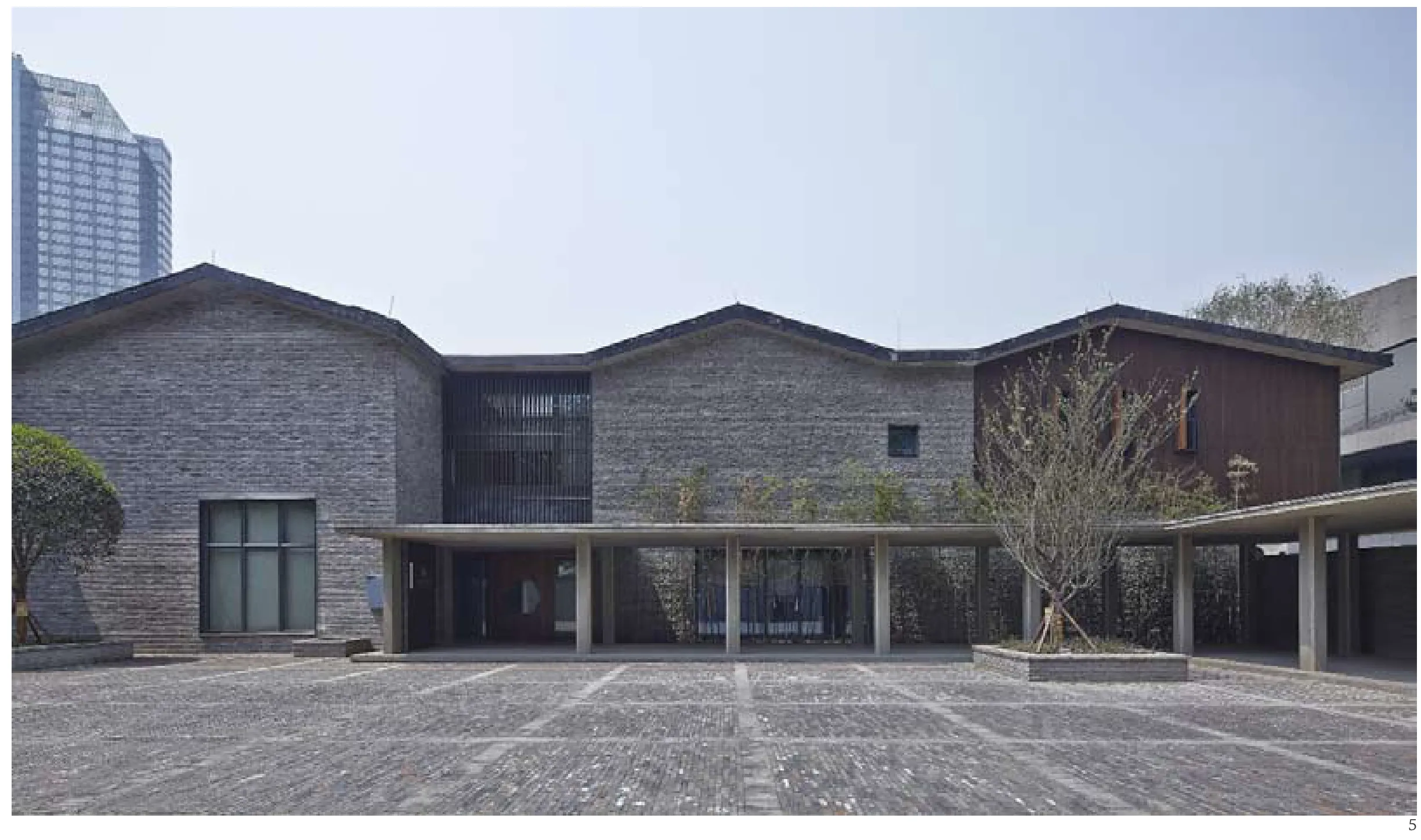
5 前院/Front yard

6 剖面/Section
WA: 您曾经说过材料是建筑师的语言,甚至是动机。您使用砖的动机是什么?地域、传统、美学还是造价?
刘家琨:有时候你说的几个因素都有。建筑设计本来就是要考虑综合因素的。
WA: 有的建筑师格外注重砌砖的工艺和砖的艺术表现力。在您的建筑中,砖用得平铺直叙,朴实无华,用您的话讲就是家常“白话”。在水井街酒坊遗址博物馆的设计中,又是如何通过这种“白话”式的材料语言与历史建筑对话的?
刘家琨:怎么用要看各人的着力点和分寸在哪里。如果砖本身巳经很好,我就表现它的本真性而不再用手法装饰性了。有时候我会微微改变一下尺寸以强化密度感,有时候会用断砖表现内部的骨料。
水井坊用的是灰色再生砖,整砖断砖都有,乍一看它和传统青砖有点相像,有利于和原有的传统青砖文物建筑协调,但其实它是我们研发的当代新材料,又不会搞得和文物建筑新旧难辨;它的骨料成分有点复杂,和酿酒的糟糠土有些气质相通。“白话”不是指“口水话”,而是指它是当下的语言,相对而言传统青砖有点像“成语”。
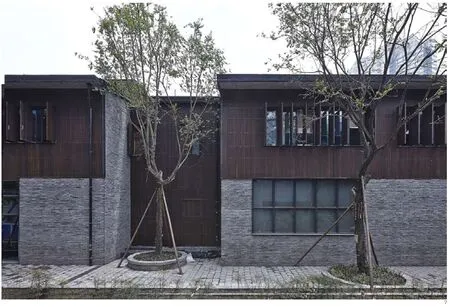
7 立面/Facade

8 砖墙前的景观/Landscape in front of brick wall
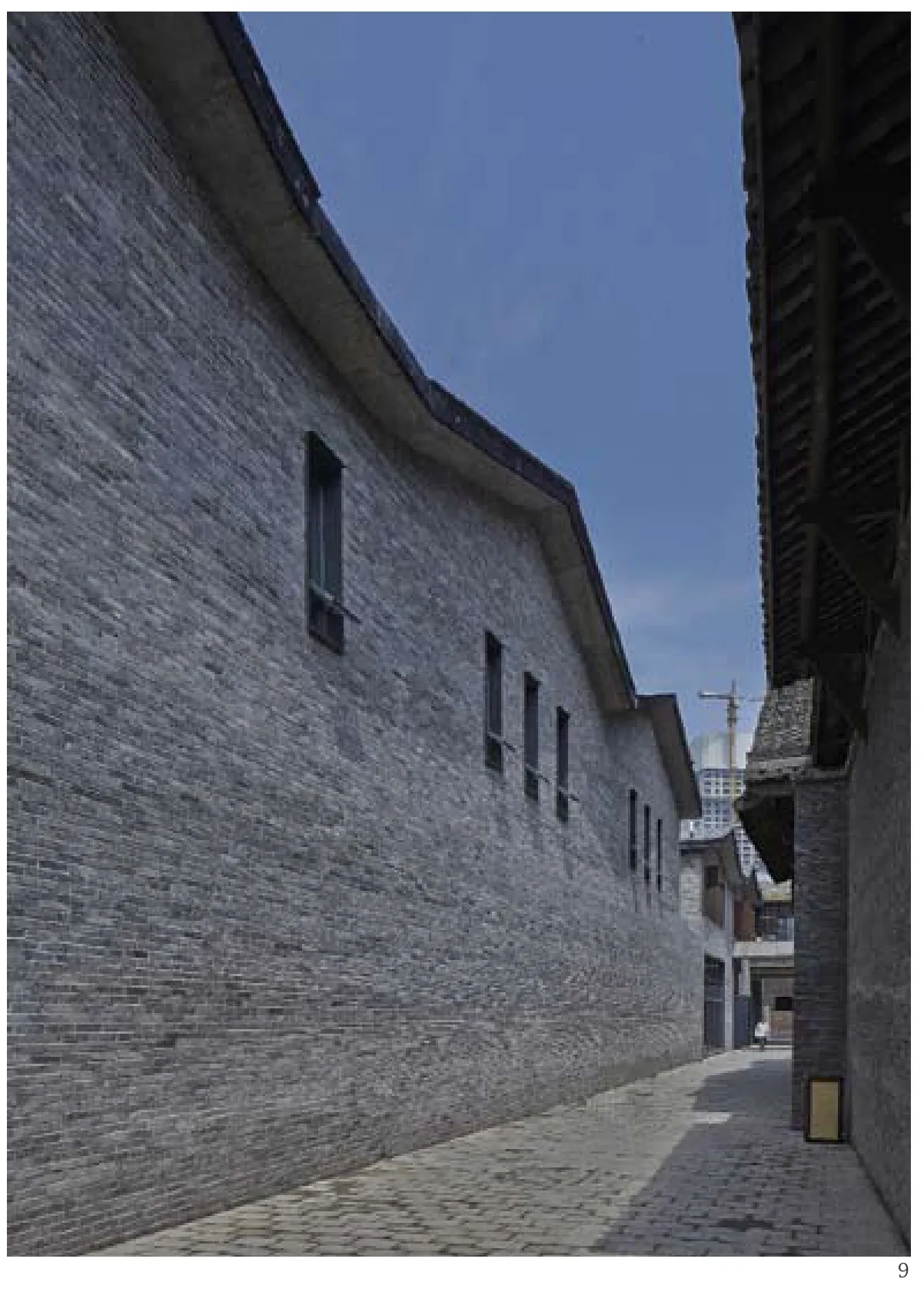
9.10 巷道/Alley

11 北立面/North elevation
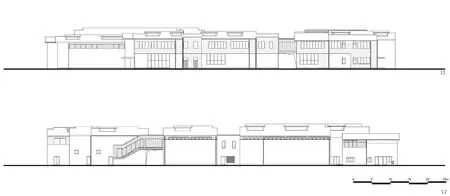
12 南立面/South elevation
WA: You once said that the material is the architect's language, and it is even his/her motivation. What is your motivation for using bricks? Is it for regional characteristics, tradition, aesthetic, or cost?
LIU Jiakun: Sometimes it is all the factors you have just said. Architectural design takes everything into account.
WA: Some architects pay particular attention to the techniques of bricklaying and the artistic expression of bricks. In your projects, bricks are used in a simplistic and naturalistic way, which in your words is "layman's terms". So how do these "layman's terms" in material language achieve a dialogue with historical architecture in the design of the Shuijingfang Museum?
LIU Jiakun: That would depend on each architect's emphasis and what he/she sees as appropriate. If the brick itself is of good quality, I will show its naturalness and refrain from using decorations. Sometimes I will alter the size slightly to enhance the density, and other times I use broken bricks to show the texture.
Shuijingfang Museum uses gray recycled bricks –whole and broken. At first sight, they might resemble our traditional gray bricks, in favor of blending into historical buildings nearby, but in fact, they are a new material – distinguishable from that of historical monuments. They have a slightly more complex aggregate composition, bearing some similarity in temperament to the pit mud used in brewing Chinese liquor. "Layman's terms" are not "tasteless" but rather they are contemporary as a language. Traditional gray brick is like "old proverbs", so to speak.
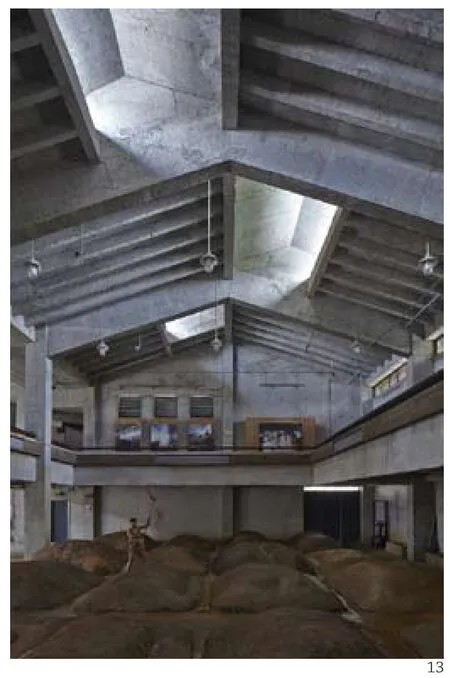
13 走廊/Corridor
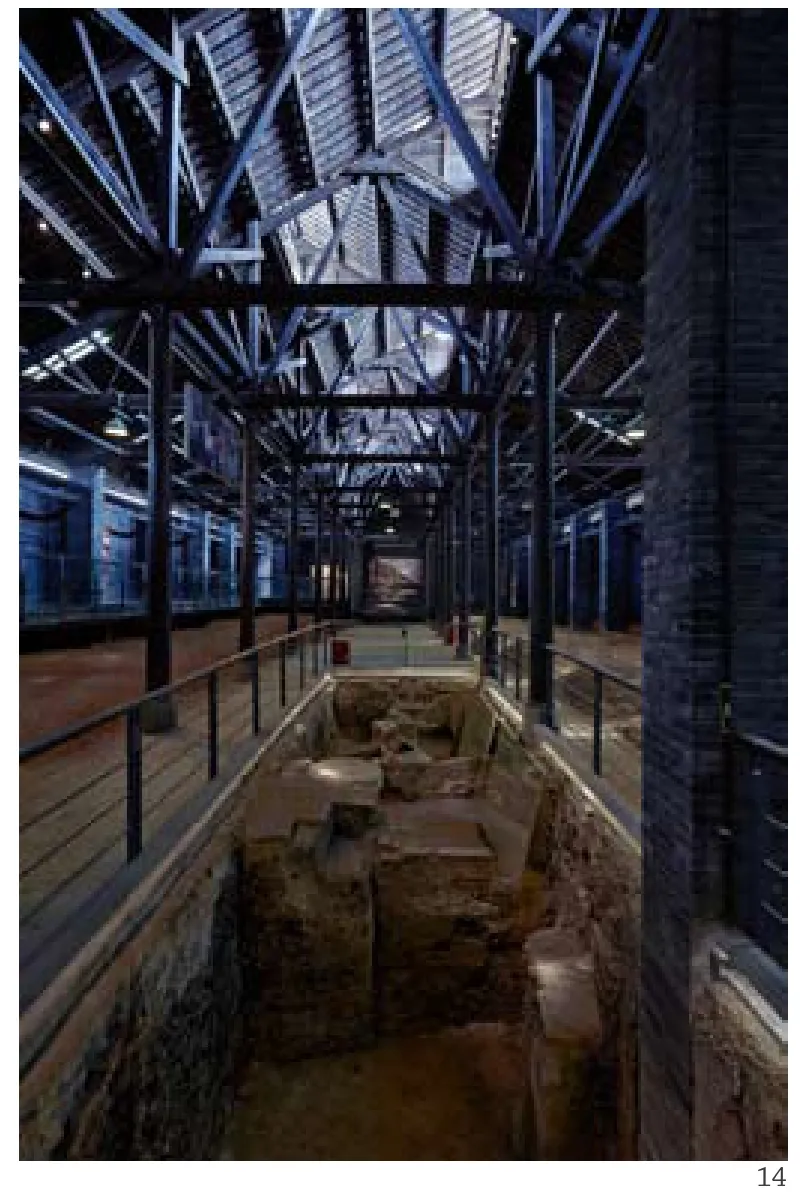
14 老作坊/Old workshop

15 新车间/New-built museum
评论
郭海鞍:这是一座新与旧结合的项目,这种新与旧不仅体现在新旧建筑结合的方式上,同样发生在新旧建筑材料的传承过程中。对于新建筑的设计,采用了拆解的方式,将大的建筑功能需求化解成小组单元,以融入周边环境尺度中,形成有机的城市更新。对于新材料的选择,采用了继承内在建构逻辑的方式,将传统材料转换为具有良好性能指标的现代建筑材料,但是其质感和建构逻辑依然保持传统的方式。整个项目于内于外,都对当地的历史和传统做了清晰准确的诠释。
Comments
GUO Hai'an: This is a project relevant to the relationship to new and old, which is not only present in the organizational differences between new and old buildings, but also in the usage of the new materials that are inherited from the old. This new building is divided into smaller units which are more in scale to the surrounding buildings, merging into the old city.The materials utilized in the new building is identical to the old materials, which may not adapt the needs of modern life. However, the logic of the construction of the old material was inherited. Both in the inside and outside the building, there is an accurate interpretation of history and traditions.
范路:在水井坊遗址博物馆项目中,新建博物馆以当代方式将场地中保留的老作坊和周边老居民区整合起来。新建筑以老民居尺度为基础,形成小体量的单元聚合,缝合了整个历史街区的城市肌理。然而,这些单元形体的长轴,都与老作坊的长轴方向平行,赋予建筑群统一的空间向度,并以U型环绕布局强化了保留建筑的核心地位。此外,设计师用钢筋混凝土框架、再生砖、重竹和瓦板岩的现代建构,表达出了传统建筑韵味。而天井与庭院、“狮子口”屋顶和沿街矮墙的设置,进一步减小了展览建筑的尺度,舒缓了空间节奏,带入了民居式的亲切感。
FAN Lu: In the project of Shuijingfang Museum,the newly-built museum integrates the preserved old workshop building on the site with the surrounding residential buildings in contemporary maneuvers. The new museum adopts the scale and style of surrounding residential buildings and harmonizes with the urban fabric of the historical district. Meanwhile the new building encircles the old workshop, and shares with it the same orientation of its long axis. In tectonic design, modern materials such as reinforced concrete,rebirth bricks and anti-corrosive bamboo are used but to create the aura of traditional construction. Furthermore, the adoption of patios, skylights and low courtyard walls reduces more the scale of the museum and brings about the sense of space in old dwellings.

16 内院天井/Couryard
